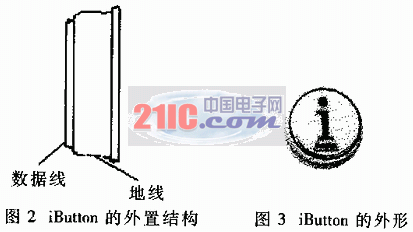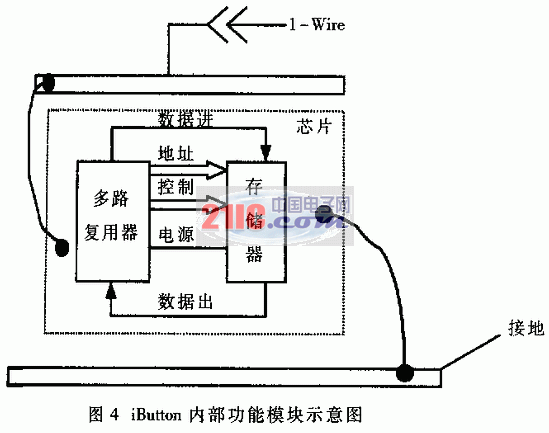Abstract: Based on the introduction of the 1-Wire bus, the 1-Wire device iButton and its working principle are introduced, and its characteristics are summarized.
Including the information button iButTIon (informaTIon Button) currently produced by Dallas Semiconductor, there are more than 30 1-Wire devices. They use a special communication protocol to solve the problems of control, communication and power supply through a single connection line. , Which reduces system cost and simplifies design, is being more and more widely used in daily life. For example, iButton has been used in financial, telecommunications, commercial and military fields.
1 1-Wire bus
The 1-Wire bus is a simple signal circuit that can exchange information with the outside world using only one data line. The common feature of 1-Wire bus devices is that each device has a serial number that should be cured at the factory and will not be repeated with any other device, that is, each device is unique. Once the serial number of the device is known, with this serial number, any device can be selected from many devices connected to the same 1-Wire bus for communication. 
When communicating, the bus controller first issues a "reset" signal to synchronize the bus, and then selects the controlled device for subsequent communication. This can be achieved by selecting a specific controlled device (using the serial number of the device for selection) or by finding the next controlled device on the bus using the half search method. Of course, all controlled devices can also be selected. Once a particular device is selected, all other devices are suspended and the subsequent communication is ignored until the bus controller issues the next "reset" signal.
The host can issue commands to all devices used for bus communication, and read and write data to it (or them). This is because each type of device runs different functions and has different uses, and once the device is selected, the protocol it uses is fixed. Even though each type of device has different protocols and features, they all have the same selection process and follow the process shown in Figure 1.
2 Introduction to iButton
iButton is a microcomputer chip encapsulated in a button-shaped stainless steel case. It has a diameter of 16 mm and a thickness of 3 to 6 mm. Can achieve duplex communication, data transmission uses a single bus protocol, so that the number of pins is reduced to a minimum: a data line, a ground wire. The inner surface of the stainless steel package is used as the data line, and the outer surface of the outer ring is used as the ground wire. See Figure 2. 
The appearance of iButton is shown in Figure 3.
There are many types of Ibutton. According to different chips, they can be divided into three categories: â‘ Memory iButton has 64KB of storage space, which can store text and digital images, and some have real-time clock (such as DS1904), temperature sensor (such as DS1921); â‘¡Java -powered crypto iButton uses high-speed processors and algorithm accelerators to process data in encryption and decryption algorithms. It can interact with Internet applications and can be used as a remote authentication solution; , You can keep the history of hot swap, and 512 bytes of additional memory is used to store the output history.
IButton can also communicate with a computer through a parallel port or a serial port, and its transmission rate can reach 142kbps. The host can be a PC, PDA or laptop, and it also needs a reading and writing device (such as Blue Dot) and a corresponding software interface, such as iButton-TMEX. 
3 How iButton works
The iButton chip is composed of a multiplexer and a memory. Its functional modules are shown in Figure 4.
Because iButton uses a single bus transmission protocol, it only needs one data line and one ground line, and the structure is extremely simple. When transmitting data, power is supplied through the data line. Microcomputer and related reading and writing devices are in the active (Master) position; iButton is in the slave (Slave) position. If the connection between iButton and Master has not been established, data transmission cannot be performed; once the connection is successfully established, it takes only a few microseconds, iButton can set the data line to low level to notify Master that the connection has been established and wait Receive the command, this pulse is called online pulse. The master can also send the "reset" signal to make the data line low. When the iButton receives the "reset" signal, by detecting the level of the data line, an online pulse can be issued immediately after the data line becomes high. See Figure 5 for the timing of reset pulse / online pulse.
After the IButton sends an online pulse, wait for the Master to issue a command. After receiving the command, the corresponding operation is performed. Since the iButton is in a subordinate position, the Master defines when each frame starts. In order to do this, the Master reads a bit of data from the data line and makes a corresponding judgment according to the status: if the iButton sends a signal "1", the next time slot is the start time of the frame; otherwise the iButton will continue Keep the data line low until a certain time of frost. Now read the data from the iButton as an example to illustrate the specific execution process: After determining the start time of the next frame, the Master first sends a read data command to the iButton. After receiving the read command, the iButton immediately sends the content of the read bit to On the data line, the microcomputer obtains data from the data line. If the data line maintains a high level in the iButton sampling time zone, the read value is "1"; otherwise, it is "0". Finally, the iButton releases the data line, and the data line returns to a high level to prepare the Master to continue reading data from the iButton. FIG. 6 shows the timing from the start of the online pulse to the end of reading data. Among them, the thick black line indicates the action of the Master, the thick gray line indicates the response of the iButton, and the thin line indicates the role of the pull-up resistor. 
4 Features of iButton
Since the iButton's silicon chip is protected in a sturdy stainless steel case, you can throw it on the ground, step on a few feet, rub it or wear it to swim. Thanks to its advanced anti-static circuit and chip, it ensures that the iButton can withstand static electricity up to 8kV and ensure the installation of itself and the stored data. The structure of IButton determines that it has the characteristics of anti-impact, waterproof, corrosion resistance, anti-magnetic interference, anti-folding, etc .; the operating temperature range is also wide, can work normally in the temperature range of -40 ℃ ~ 80 ℃, suitable for harsh Environment; it can be embedded in rings, keychains, wallets or watches, easy to carry around.
In addition, iButton's wide application is also due to its outstanding features that magnetic cards and IC cards do not have. The specific manifestations are:
(1) Large storage capacity: the maximum data storage capacity of iButton can reach 64KB, such as DS2506 has 64KB EPROM memory, DS1996 has 64KB NVRAM memory.
(2) Fast speed: when reading and writing data, it only needs to lightly touch the contacts, and it can be completed in an instant, and its transmission rate can reach 142kbps.
(3) High security: each chip has a unique 64-bit serial number in the world. The serial number is engraved on the chip by laser technology at the factory, and a protective layer is added, which is unforgeable. Any attempt to change the serial number Will cause errors in the CRC verification process.
(4) Low cost: The cost of the reader used by iButton is only more than 100 yuan, and the maintenance cost is less than 0.01%. The iButton has high stability, low failure rate, and a very high cost performance ratio. 
(5) Long lifespan: iButton's stainless steel housing has a built-in high-performance lithium battery, and its power consumption is very low, which can ensure the storage of its data for more than 10 years. There is no limit to the number of times it can be used, and it can be used indefinitely.
The various advantages of IButton determine that it must have broad application prospects.
Wireless Fence,Wireless Dog Collar,Wireless Dog Fence,Wireless Electric Dog Fence
Elite-tek Electronics Ltd , https://www.aetertek.ca